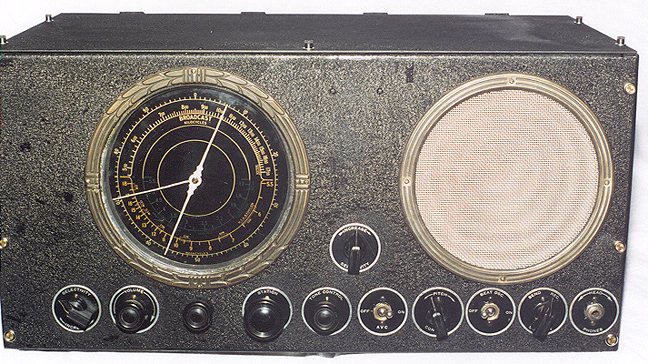| The card above the globe reads "Radio Station -W8PGL- operator, R. Banks" | ||
This snapshot was found in a box of old tubes. The photo was cleaned and kept in a book to flatten it out. While looking through some old copies of the amateur radio magazine, QST, we were surprised to find a cropped version of the snapshot on page 19 of the April 1937 issue!
The events surrounding the photo and others like it are the subject of a nine page QST article with the title:
The '37 Ohio River Valley flood was described by the head of the American Red Cross as the greatest emergency since the World War. The story depicts the experiences of ham radio operators who provided what was often the only outside link for a number of stricken cities and towns as the crest of the flood wiped out all other forms of communication.
| The card above the globe reads "Radio Station -W8PGL- operator, R. Banks" | ||
The text surrounding the photo reads:
"Further on, at Wheelersburg, Russell W. Banks, W8PGL aided by W8PFT (on the right, identified in the photo caption as Joe Price, relief operator), provided the only contact for the community cut off for a full week after the flood crisis. Operating on 75 meter 'phone at times from a 32 volt converter powered with banks of freely contributed automobile batteries, this station secured all supplies and aid for the flooded communities of Wheelersburg, Allen Township and Sciotoville. Warning was also given lower cities of thousands of gallons of gasoline which filmed the river water forming a gigantic fire hazard."The photo is part of Ham Radio's continuing legacy of providing life-saving emergency communications.
W8PGL also wrote a letter to the RADIO NEWS magazine detailing his experiences. The letter was published in the September 1938 issue as a winning entry in "My greatest thrill in radio."

The transmitter is homebrew, but W8PGL's handsome receiver is a
In the mid-thirties, catalog stores such as Sears and Wards were heavily into radio and made alliances with various manufacturers. The Silvertone 8A resembles the Hallicrafters S8A as well as the Hallicrafters Super Seven and its twin, the Montgomery Ward Super Seven (Radio News, January 1936, page 398) (also see the Montgomery Ward Airline Professional Model 37 reviewed in Radio News, October 1935), but the tuning dial and speaker positions are reversed. The dial and speaker are also larger in the Silvertone.
Greg Gore, WA1KBQ, was the first to write and correctly identify this set as a Silvertone. Dan Merz provided this scan of his photograph of the set with permission to publish it on this site.
The set was manufactured for Sears by the Howard Radio Co. The schematic in Rider 10, Sears page 33, was drawn by the same draftsman (initials M. B.) as a number of schematics listed under Howard Radio. Howard Radio is also believed to have manufactured the Hallicrafters / Wards Super Seven models.
The device to the right of the 8A in the ham shack photo is a Clough-Brengle model 82 signal generator, advertised in Radio News, April 1936.
Update from Russell Banks' granddaughter 8-2004 as written in the guestbook
The story "My greatest thrill in Radio" about the Silvertone in a 1937 Ham Shack was written by my Grandfather, Russell W. Banks. He is gone now, and we had never seen that photo of him. My mother, Janet Sue Banks doesn't have a computer so I am mailing her this print out today. I told her about it last night, and she just can't wait to see it and read his story! I'm sure my grandfather would never have dreamed when he wrote it he would end up Retired Full Col. Navy and retired from the FCC. My mother said he worked for Sears at the time he bought his Silvertone.
Thank-you
Velvet D. Maddox